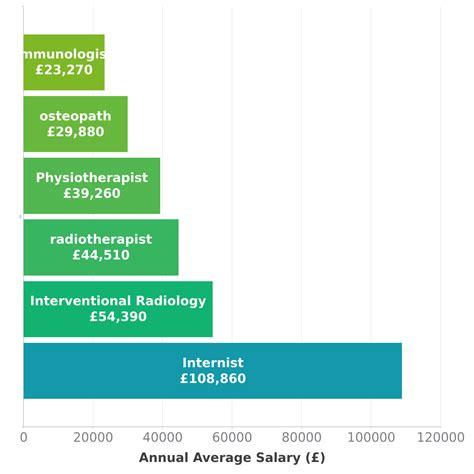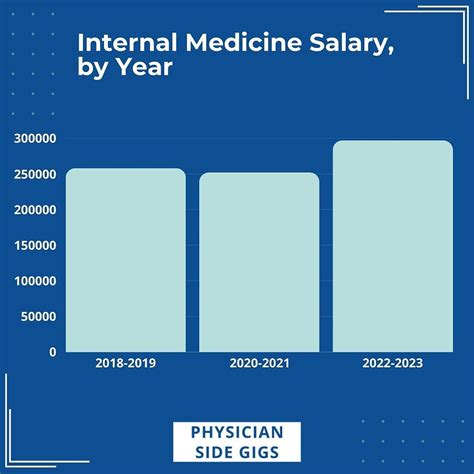A career in internal medicine is one of the most respected and vital paths in the healthcare industry. Internists, the "doctors for adults," are the backbone of adult primary care and hospital medicine. For those considering this challenging yet rewarding profession, a key question is always: what is the earning potential?
The answer is encouraging. A career as an internist offers significant financial stability, with average salaries comfortably in the six-figure range, often exceeding $270,000 annually. However, this figure is just the starting point. Your actual earnings can vary dramatically based on a number of critical factors. This article will provide a comprehensive breakdown of an internist's salary and the key variables that influence it.
What Does an Internist Do?

Before we dive into the numbers, let's clarify the role. An internist, or internal medicine physician, specializes in the diagnosis, treatment, and prevention of diseases in adults. They are trained to manage complex medical conditions and often serve as primary care physicians, coordinating a patient's overall care.
Their responsibilities include:
- Conducting comprehensive physical exams.
- Diagnosing and treating a wide spectrum of illnesses, from common infections to chronic conditions like diabetes and heart disease.
- Prescribing medication and other treatments.
- Providing long-term, comprehensive care.
- Many internists work as hospitalists, focusing exclusively on caring for patients within a hospital setting, while others work in outpatient clinics.
Average Internist Salary

The compensation for an internist is substantial, reflecting the extensive education, rigorous training, and critical responsibilities of the role.
According to the Medscape Physician Compensation Report 2023, one of the most respected annual surveys in the industry, the average salary for a general internist is approximately $273,000 per year. This report also notes that internists receive an average incentive bonus of around $30,000, bringing potential total compensation even higher.
Other authoritative sources provide a similar picture:
- Salary.com reports a median salary for an internist in the United States of $257,015 as of late 2023, with a typical range falling between $231,529 and $293,026.
- The U.S. Bureau of Labor Statistics (BLS) groups internists under "General Internal Medicine Physicians" and reports a median annual wage of $225,270 in May 2022. It's important to note that the BLS data can sometimes lag behind industry-specific reports like Medscape, which survey physicians directly for the most current year.
This data shows a clear consensus: an entry-level internist just out of residency can expect to earn over $200,000, while experienced physicians in high-demand settings can earn well over $300,000.
Key Factors That Influence Salary

Your salary as an internist is not a single, fixed number. It is influenced by a combination of factors, from your educational choices to where you decide to practice.
### Level of Education
The path to becoming an internist is long and demanding, which is a primary reason for the high salary. This includes a four-year bachelor's degree, four years of medical school (to earn an M.D. or D.O.), followed by a three-year residency in internal medicine.
While this baseline education is standard, pursuing further training through a fellowship dramatically impacts earning potential. This leads directly to our next point on specialization.
### Area of Specialization
General internal medicine is a specialty in itself, but many internists choose to sub-specialize by completing a fellowship (an additional 1-3 years of training). This is one of the most significant drivers of increased income. Subspecialists who treat specific organ systems or disease categories command much higher salaries.
Here's a comparison based on Medscape's 2023 data:
| Specialty | Average Annual Salary |
| :--- | :--- |
| General Internal Medicine | $273,000 |
| Rheumatology | $289,000 |
| Endocrinology | $267,000 |
| Pulmonology (Lungs) | $378,000 |
| Gastroenterology (Digestive) | $501,000 |
| Cardiology (Heart) | $507,000 |
As the data shows, sub-specializing in a field like cardiology or gastroenterology can nearly double an internist's average salary.
### Years of Experience
Like any profession, experience pays. Physicians who have been practicing for many years have had time to build patient panels, increase their efficiency, and take on more senior or partnership roles.
- Entry-Level (0-5 years): Physicians right out of residency will typically earn on the lower end of the salary spectrum, often in the $200,000 to $240,000 range.
- Mid-Career (6-15 years): With established experience, internists see their income rise significantly, often aligning with or exceeding the national average of $270,000.
- Senior-Level (15+ years): Highly experienced internists, especially those in private practice or leadership roles, can command salaries well over $300,000.
### Geographic Location
Where you practice medicine has a major impact on your salary. States and regions with a higher demand for physicians, particularly in rural or underserved areas, often offer higher compensation to attract talent. Conversely, major metropolitan areas with a high density of physicians and a desirable quality of life may offer slightly lower salaries.
According to industry reports, some of the highest-paying states for physicians (including internists) are often in the Midwest and Southeast, such as:
- Wisconsin
- Indiana
- Georgia
- Connecticut
It's crucial to balance salary with the cost of living. A $280,000 salary in a low-cost-of-living state may provide more disposable income than a $300,000 salary in an expensive coastal city.
### Company Type
The setting where an internist works is a key determinant of both salary and overall compensation structure.
- Private Practice (Partner/Owner): This setting offers the highest earning potential. According to Medscape, self-employed physicians (including practice owners) earn significantly more than employed physicians. However, this comes with the added responsibilities of running a business, including overhead, billing, and administrative duties.
- Hospital or Health System-Employed: This is a common and stable career path. Hospitals offer competitive, guaranteed salaries with benefits and often handle all administrative burdens. The income is reliable but may have a lower ceiling than private practice ownership.
- Outpatient Clinics: These can be part of a large healthcare network or a smaller group. Compensation is often strong and may include productivity bonuses based on the number of patients seen.
- Academic Medical Centers: Internists working in academia (teaching hospitals) typically earn the least. However, the trade-off includes benefits like teaching opportunities, research access, and often a better work-life balance.
Job Outlook

The future for internists is exceptionally bright. The U.S. Bureau of Labor Statistics (BLS) projects that employment for physicians and surgeons will grow by 3% from 2022 to 2032, which is about as fast as the average for all occupations.
This steady demand is driven by several factors:
- An aging U.S. population requires more care for chronic and complex conditions.
- A greater emphasis on preventative care.
- A projected shortage of physicians, particularly in primary care fields like internal medicine.
This outlook ensures long-term job security and sustained salary potential for those entering the field.
Conclusion

A career as an internist is a commitment to lifelong learning and patient care, and it is rewarded with a secure and lucrative salary. While the national average hovers around $270,000, your individual earning potential is in your hands.
To maximize your salary, consider these key takeaways:
- Sub-specialize: Pursuing a fellowship in a high-demand field like cardiology or gastroenterology is the most direct path to a higher income.
- Be strategic about location: Consider practicing in regions with a high demand for physicians and a favorable cost of living.
- Evaluate your practice model: Weigh the high-risk, high-reward potential of private practice against the stability of hospital employment.
- Gain experience: Your value and income will naturally grow as you build your skills and reputation over time.
For those with the dedication to complete the rigorous training, internal medicine offers a professionally and financially rewarding career at the very heart of healthcare.
